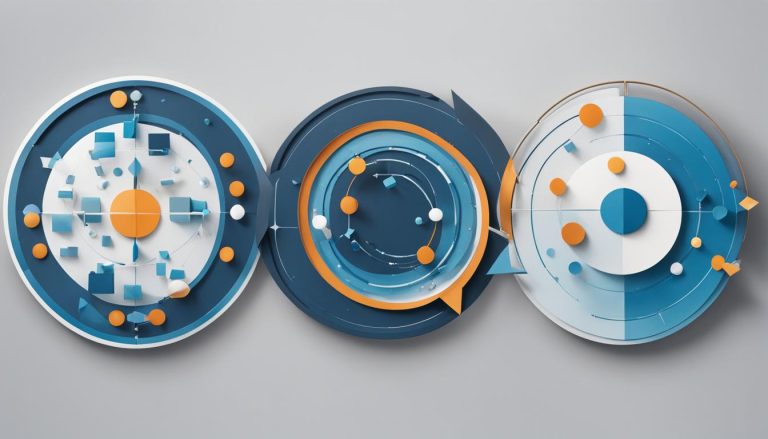Welcome to my article on CockroachDB, a distributed SQL database that has been gaining popularity in recent years. If you’re unfamiliar with CockroachDB or curious about its features, you’ve come to the right place. In this article, I will provide you with an overview of what CockroachDB is, its distributed architecture, and some key differentiators compared to other database management systems. Let’s dive in!
Key Takeaways:
- CockroachDB is a distributed SQL database designed for high availability, fault tolerance, and horizontal scalability.
- Its architecture is inspired by Google’s Spanner, utilizing a shared-nothing design.
- CockroachDB is a popular choice for applications that require global access to data and low-latency performance.
- Compared to traditional databases like PostgreSQL, CockroachDB offers scalability, high availability, and built-in replication mechanisms.
- CockroachDB and PostgreSQL have different consistency models, with CockroachDB utilizing the Raft consensus algorithm for strong consistency across nodes.
CockroachDB Architecture: How It Differs from PostgreSQL
When comparing CockroachDB and PostgreSQL, one of the key differences lies in their architectural approach. PostgreSQL follows a traditional single-master architecture, where a single node coordinates read and write operations. On the other hand, CockroachDB is built on a distributed, shared-nothing architecture. This means that data is distributed across multiple nodes, allowing for high availability, fault tolerance, and horizontal scalability.
The shared-nothing architecture of CockroachDB sets it apart from PostgreSQL. In CockroachDB, data is partitioned and stored across several nodes, which can be geographically distributed. This design enables CockroachDB to handle large workloads by distributing the processing power and storage across multiple nodes. In contrast, PostgreSQL’s single-master architecture is limited to the capabilities of a single node, making it more suitable for smaller workloads or applications that don’t require massive horizontal scalability.
With its distributed architecture, CockroachDB also offers better fault tolerance compared to PostgreSQL. If a node fails, CockroachDB automatically redistributes the data and workload to other nodes in the cluster, ensuring continuous availability. In contrast, PostgreSQL may require external tools or solutions for managing failover and ensuring high availability in the event of node failures.
Differences between Shared-Nothing and Single-Master Architectures
The shared-nothing architecture used by CockroachDB involves distributing data and processing across multiple nodes, facilitating fault tolerance and scalability. In contrast, PostgreSQL’s single-master architecture relies on a single node to coordinate read and write operations, which can limit scalability and fault tolerance.
The choice between CockroachDB and PostgreSQL’s architecture ultimately depends on the specific needs of an application. If horizontal scalability, fault tolerance, and high availability are crucial requirements, CockroachDB’s shared-nothing architecture may be the preferred option. However, if the workload is smaller and doesn’t require global scalability, PostgreSQL’s single-master architecture may be a more suitable choice.
Scalability and High Availability in CockroachDB
When it comes to scalability and high availability, CockroachDB stands out as a top choice. Its distributed architecture allows it to handle increasing workloads by adding more nodes to the cluster, ensuring horizontal scalability. This means that as your application grows and requires more resources, CockroachDB can seamlessly accommodate the demand without compromising performance or availability.
Moreover, CockroachDB incorporates built-in replication and fault tolerance mechanisms, eliminating the need for external solutions. This ensures that even in the event of node failures or network disruptions, CockroachDB can maintain data availability and consistency. The ability to automatically replicate data across multiple nodes also enhances the durability and reliability of the system.
On the other hand, while PostgreSQL can scale vertically by adding more resources to a single node, it may require external tools or configurations for managing failover and load balancing. This can introduce additional complexity and potential points of failure. In terms of high availability, CockroachDB offers a more robust and integrated solution, simplifying the management and maintenance of a fault-tolerant database system.
Table: Scalability and High Availability Comparison
| Database System | Scalability | High Availability |
|---|---|---|
| CockroachDB | Horizontal scalability with seamless addition of nodes | Built-in replication and fault tolerance mechanisms |
| PostgreSQL | Vertical scalability by adding more resources to a single node | Potentially requires external solutions for failover and load balancing |
In summary, CockroachDB offers the scalability and high availability required for modern applications. Its distributed architecture allows for seamless horizontal scalability, while built-in replication and fault tolerance mechanisms ensure data availability and consistency. In comparison, PostgreSQL may require additional configurations or tools for scaling and managing high availability. Therefore, if you’re looking to build a scalable and fault-tolerant database system, CockroachDB is a compelling choice.
CockroachDB and PostgreSQL: Consistency Models and Concurrency Handling
When it comes to handling concurrent operations and ensuring data consistency, CockroachDB and PostgreSQL take different approaches. Both databases adhere to ACID principles, ensuring strong consistency, but they utilize distinct methodologies to achieve this.
CockroachDB Consistency Models and the Raft Consensus Algorithm
CockroachDB utilizes a distributed consensus algorithm called Raft to achieve strong consistency across nodes. This approach ensures that data is replicated and synchronized in a distributed environment, enabling CockroachDB to handle global access and maintain consistency even in the face of network partitions or node failures.
The Raft consensus algorithm implemented by CockroachDB follows a leader-election protocol, where a single node acts as the leader and coordinates read and write operations. The other nodes, called followers, replicate the leader’s state and participate in the consensus process to ensure that all operations are performed consistently across the cluster.
“CockroachDB’s use of the Raft consensus algorithm allows it to achieve strong consistency across distributed nodes, making it suitable for globally distributed applications that require data integrity and reliability.” – Database Expert
PostgreSQL’s ACID Compliance and Single-Node Consistency
On the other hand, PostgreSQL follows a traditional ACID model, providing strong consistency within a single node. It ensures that transactions are atomic, consistent, isolated, and durable. However, PostgreSQL’s consistency model is limited to a single node, making it less suitable for distributed applications that require global consistency.
While PostgreSQL offers various mechanisms for ensuring consistency within a single node, such as locking and multi-version concurrency control (MVCC), it may require external tools or additional configurations to achieve consistency across multiple nodes and handle distributed data management.
Choosing the Right Consistency Model for Your Application
The choice between CockroachDB’s distributed consistency model and PostgreSQL’s single-node consistency model depends on the specific requirements of your application. If your application needs global consistency, fault tolerance, and scalability, CockroachDB’s approach utilizing the Raft consensus algorithm may be a better fit. On the other hand, if your application primarily operates within a single node and requires advanced SQL features and ecosystem support, PostgreSQL may be the more suitable choice.
Consider factors such as the geographic distribution of your application, the need for concurrent operations and scalability, and the reliance on external tools for handling consistency. Evaluating these factors will help you determine which database system, CockroachDB or PostgreSQL, aligns best with your specific needs.
CockroachDB vs. PostgreSQL: SQL Support and Compatibility
When comparing CockroachDB and PostgreSQL, it’s essential to evaluate their SQL support and compatibility. Both databases offer extensive SQL capabilities, but there are differences to consider.
CockroachDB aims to be compatible with PostgreSQL’s SQL dialect, allowing most PostgreSQL queries and statements to work seamlessly. This compatibility makes it easier for developers familiar with PostgreSQL to transition to CockroachDB without significant modifications to their existing SQL code.
However, it’s important to note that due to the distributed nature of CockroachDB, there may be some limitations or differences in specific features or optimizations compared to PostgreSQL. These limitations can vary depending on the specific requirements of the application. It’s crucial to thoroughly test and evaluate the compatibility of your SQL code when migrating to CockroachDB from PostgreSQL.
“CockroachDB aims to be compatible with PostgreSQL’s SQL dialect, allowing most PostgreSQL queries and statements to work seamlessly.”
PostgreSQL, on the other hand, has a mature ecosystem with advanced indexing options, full-text search capabilities, and support for custom data types. It offers a wide range of features that cater to diverse application needs. If your application heavily relies on specific PostgreSQL features or requires advanced indexing or full-text search capabilities, PostgreSQL may be the more suitable option.
In summary, both CockroachDB and PostgreSQL provide robust SQL support, but CockroachDB’s compatibility with PostgreSQL’s SQL dialect and its distributed nature may introduce some limitations or differences in certain features. Evaluating the specific requirements of your application and considering the potential limitations of each database will help you make an informed decision.
| Database | SQL Support | Compatibility with PostgreSQL | Limitations |
|---|---|---|---|
| CockroachDB | Extensive | Compatible with PostgreSQL’s SQL dialect | Potential limitations due to distributed nature |
| PostgreSQL | Advanced | N/A | No limitations |
Performance Comparison: CockroachDB vs. PostgreSQL
When it comes to performance, both CockroachDB and PostgreSQL have their strengths and are capable of delivering excellent results. However, the specific use case and workload play a significant role in determining which database system is the better choice.
PostgreSQL, with its single-node architecture, can provide better performance for scenarios that don’t require massive horizontal scalability. It excels in delivering high performance for workloads that can be efficiently handled by a single node.
On the other hand, CockroachDB’s distributed architecture allows it to scale out and handle high write and read workloads across multiple nodes. This makes it a suitable choice for highly concurrent applications or scenarios with rapidly growing data. CockroachDB’s ability to distribute data across multiple nodes enables it to handle larger workloads and provide low-latency performance.
While PostgreSQL might offer better performance for certain scenarios, CockroachDB’s distributed architecture and scalability make it a powerful option for applications that require global access to data and high availability.
Workload Optimization
Optimizing performance in both CockroachDB and PostgreSQL involves considering the specific requirements and characteristics of the workload. Here are some factors to consider when optimizing performance:
- Indexing: Properly indexing the data can significantly improve query performance in both database systems.
- Caching: Implementing effective caching strategies can reduce the need for frequent disk access and improve overall performance.
- Data Partitioning: Distributing data across multiple nodes can help achieve better parallelism and performance.
- Query Tuning: Analyzing and optimizing the queries can lead to significant performance improvements.
By carefully considering and implementing these optimization techniques, developers can ensure that both CockroachDB and PostgreSQL deliver optimal performance for their specific workloads.
| CockroachDB | PostgreSQL | |
|---|---|---|
| Scalability | Horizontal scalability with distributed architecture | Vertical scalability with single-node architecture |
| High Availability | Built-in replication and fault tolerance mechanisms | May require external tools for managing failover |
| Performance | Handles high write and read workloads across multiple nodes | Provides better performance for scenarios that don’t require massive scalability |
Overall, both CockroachDB and PostgreSQL have their strengths in terms of performance. The choice between the two depends on the specific requirements of the application and the nature of the workload. Consider the scalability needs, desired performance characteristics, and workload optimization techniques to make an informed decision.
Conclusion: Choosing the Right Database System
In my assessment, both CockroachDB and PostgreSQL are robust and capable database management systems, each with its own strengths and ideal use cases. PostgreSQL boasts a mature ecosystem, strong consistency, and extensive SQL support, making it a reliable choice for a wide range of applications.
On the other hand, CockroachDB shines in scalability, high availability, and fault tolerance, making it particularly well-suited for applications requiring distributed data and global accessibility. With its distributed architecture and ability to handle large workloads across multiple nodes, CockroachDB is an excellent option for highly concurrent applications or scenarios with rapidly growing data.
When making a selection between CockroachDB and PostgreSQL, it is crucial to consider the specific requirements of the project, scalability needs, desired consistency models, and the geographic distribution of the application. Both systems have their merits, and the decision ultimately depends on the unique demands of your project.
By carefully evaluating these factors and understanding the differences between CockroachDB and PostgreSQL, you can confidently choose the right database system that aligns with your needs and enables your application to thrive.
FAQ
What is CockroachDB?
CockroachDB is a distributed SQL database that offers a range of features and capabilities. It is built on a distributed architecture inspired by Google’s Spanner, utilizing a shared-nothing design.
How does CockroachDB differ from PostgreSQL?
CockroachDB is built on a distributed, shared-nothing architecture, while PostgreSQL follows a traditional single-master architecture. This difference allows CockroachDB to achieve high availability, fault tolerance, and horizontal scalability.
What are the scalability and high availability features of CockroachDB?
CockroachDB excels in scalability and high availability by allowing the addition of more nodes to the cluster, ensuring horizontal scalability. It incorporates built-in replication and fault tolerance mechanisms, making it highly available without the need for external solutions.
How do CockroachDB and PostgreSQL handle concurrent operations?
CockroachDB uses a distributed consensus algorithm called Raft to achieve strong consistency across nodes. PostgreSQL follows a traditional ACID model, providing strong consistency within a single node.
What is the SQL support and feature set of CockroachDB and PostgreSQL?
Both CockroachDB and PostgreSQL offer extensive SQL support and a wide range of features. CockroachDB aims to be compatible with PostgreSQL’s SQL dialect, allowing most PostgreSQL queries and statements to work seamlessly.
How does performance compare between CockroachDB and PostgreSQL?
The performance of CockroachDB and PostgreSQL depends on the specific use case and workload. PostgreSQL may provide better performance for scenarios that don’t require massive horizontal scalability, while CockroachDB excels in highly concurrent applications or rapidly growing data scenarios.
When choosing between CockroachDB and PostgreSQL, what factors should be considered?
The choice between CockroachDB and PostgreSQL depends on specific requirements, scalability needs, desired consistency models, and geographic distribution of the application.
Claudia loves to discover the world and conquer new software products every now and then.


